1
The bedding is constructed in the engine house2003
Winterton Boat Building and Community Museum, Newfoundland and Labrador, Canada
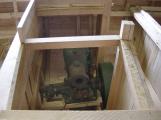
2
The boat was ready for construction of the bedding in the engine house, upon which the engine would be secured. This bedding was carefully located and sized for the engine and was usually constructed of four heavy timber pieces, two running length wise and two running width wise. Holes were cut into the hull for the water intake and outlet fittings, as these engines were water-cooled. The top of the engine house had a hole cut for the exhaust pipe. A hole was also cut into the side of the engine house to gain access to the fuel tank, which would be located inside. The heavy engine itself was then lifted onto the bedding with the aid of several helpers and a rope sling connected onto a long stick or plank. The engine and shaft were then aligned and the fuel and electrical connections made.3
View of the engine house in relation to the counter2003
Winterton Boat Building and Community Museum, Newfoundland and Labrador, Canada
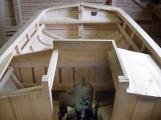
4
When the bedding was in place and shaft hole was drilled, the propeller, located at the base of the rear of the boat, was then connected to the engine to give it power.5
Installing the engine2003
Winterton Boat Building and Community Museum, Newfoundland and Labrador, Canada
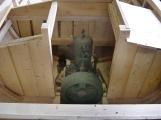
6
The gasoline-powered, make-and-break engine was then installed onto the engine bedding using bolts. This particular model is the 4 horsepower Atlantic.7
Make-and-break engines (left to right): Acadia, Barnes and Hubbard2003
Winterton Boat Building and Community Museum, Newfoundland and Labrador, Canada
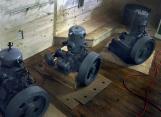
8
There were many different kinds of make-and-break gasoline engines used at Winterton over the years. Models used included Acadia, Atlantic, Barnes, Bridgeport and Hubbard.9
Make-and-break engine2003
Winterton Boat Building and Community Museum, Newfoundland and Labrador, Canada
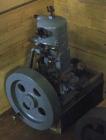
10
This make-and-break engine is a 6 ½ horsepower Acadia.11
Hanging the rudder and painting the boat2003
Winterton Boat Building and Community Museum, Newfoundland and Labrador, Canada
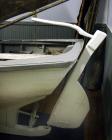
12
An outboard rudder was constructed and hung from the counter. The base of the rudder was located just behind the propeller so its momentum could be directed. The rudder was made from local spruce or fir planks and was attached to the counter with a system of eye bolts, which acted as a hinge, and a straight bolt at the bottom, which swung in a fitting on the keel. The tiller stick (steering stick) was usually a straight wooden piece fitted to the rudder-head that extended 4 to 6 inches over the top of the counter.Most communities had their own colour preferences for painting their boats. All Winterton boats were painted in shades of black, white and gray. Typically two coats of white marine or exterior house paint were applied with the first coat being thinned with linseed oil or turpentine. Grey paint, which was created by mixing a little black with the white paint, was often used for the inside and the gunwales. Black trim might be used on the rubbers.
A name was not painted on the side of the boat as small fishing boats were never named. Winterton fishermen were no more likely to name their boat then they were to name a wheel barrow.
13
A score hole for sculling2003
Winterton Boat Building and Community Museum, Newfoundland and Labrador, Canada
